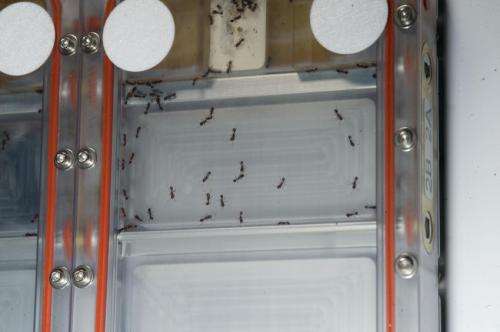April 1, 2015 report
Ants in space find it tougher going than those on Earth

(Phys.org)—The results of a study conducted to see how well ants carry out their search activities in space are in, and the team that sent them there has written and published the results in the journal Frontiers in Ecology and Evolution. They found that while the ants demonstrated a remarkable capacity to adapt to the weightlessness of space, they still found it much more difficult than ants performing the same sorts of activities back here on Earth.
Last summer, a team of researchers in the U.S. affiliated with several institutions across the country described experiments they were planning to conduct with ants by sending some to the International Space Station—they wanted to know how the ants would change their searching activities to compensate for the lack of gravity. Those experiments have been carried out and the team now reports that the ants showed a remarkable degree of adaptability and tenacity in carrying out their searching activities.
Scientists still do not understand how ants band together as a unit to get work done—there is no central leader yet different ants fill different roles and all the things that need to happen to build and maintain a colony happen, most particularly, foraging, where ants check out new territory and then bring back food. Scientists know that the ants communicate by smelling antennae, or chemicals left on trails, but other than that, are baffled. The researchers on this new project were hoping watching ants deal with space conditions might help in understanding how they do what they do.
The experiments consisted of having a group of ants start off in a box that served as a nest. At some point, a door would be opened allowing the ants access to new territory—they were filmed as they moved into the new territory and began searching. In watching the video, the researchers noted that the ants were far less efficient than ants in the exact same conditions back on Earth, they spent much more time simply trying to cling to walls, and quite often found themselves slipping and hanging in the air—oftentimes for several seconds, until they found something they could grab onto to bring them back to their task area—the end result was less territory searched or re-searched and more time taken to find resources.
Thus far, it does not appear the ants in space experiment has yielded much else in the way of explaining how the ants know what to do and when, but, the team suggests, their ability to adapt to new surroundings and to continue searching might help other scientists looking to develop better computer algorithms for programming robots to do the same sorts of things.
More information: Collective search by ants in microgravity, Front. Ecol. Evol., 30 March 2015. DOI: 10.3389/fevo.2015.00025
Abstract
The problem of collective search is a tradeoff between searching thoroughly and covering as much area as possible. This tradeoff depends on the density of searchers. Solutions to the problem of collective search are currently of much interest in robotics and in the study of distributed algorithms, for example to design ways that without central control robots can use local information to perform search and rescue operations. Ant colonies operate without central control. Because they can perceive only local, mostly chemical and tactile cues, they must search collectively to find resources and to monitor the colony's environment. Examining how ants in diverse environments solve the problem of collective search can elucidate how evolution has led to diverse forms of collective behavior. An experiment on the International Space Station in January 2014 examined how ants (Tetramorium caespitum) perform collective search in microgravity. In the ISS experiment, the ants explored a small arena in which a barrier was lowered to increase the area and thus lower ant density. In microgravity, relative to ground controls, ants explored the area less thoroughly and took more convoluted paths. It appears that the difficulty of holding on to the surface interfered with the ants' ability to search collectively. Ants frequently lost contact with the surface, but showed a remarkable ability to regain contact with the surface.
© 2015 Phys.org




















